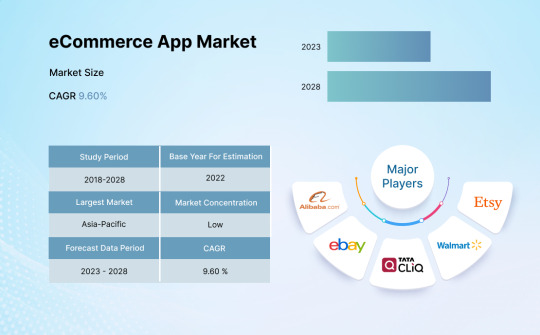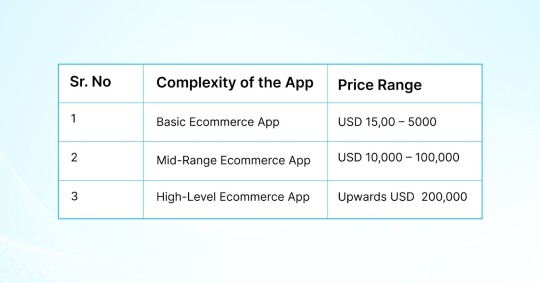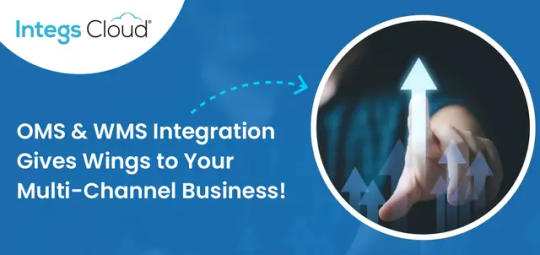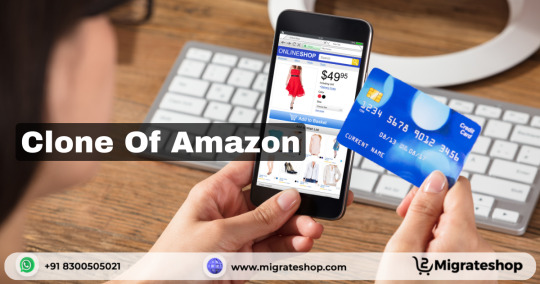#Amazon Selling Partner API
Explore tagged Tumblr posts
Text
The Amazon Selling Partner API (SP API) is a powerful tool that provides third-party developers and sellers with programmatic access to Amazon's vast marketplace. It offers a range of features and benefits that streamline and enhance the selling experience on Amazon.
0 notes
Text
Amazon Launches a Revolutionary Selling Partner API for Vendors
Introduction:
Amazon, the world's largest online marketplace, has recently introduced a groundbreaking solution for sellers and vendors called the Selling Partner API (SP-API). This new API offers a modernized approach to automated operations, analytics, and seller insights, revolutionizing the way businesses interact with the Amazon platform. In this blog post, we will delve into the key aspects of the Amazon Selling Partner API and explore how it benefits businesses.
What is the SPI-API? A REST-based API called the Selling Partner API gives vendors and sellers programmatic access to a number of features, including listings, orders, payments, reports, and more. Similar to its predecessor, the Amazon Marketplace Web Service (MWS), the Selling Partner API enables sellers to automate processes, optimize ad spend, gain valuable insights into customer behavior, and make informed inventory management decisions. To improve e-commerce analytics and operations, it also enables integration with third-party tools and services.

Why the change from Amazon MWS to the Selling Partner API?
Modernizing technology and enhancing functionality are represented by the switch from Amazon MWS to the Selling Partner API. While MWS has served businesses well for over a decade, the Selling Partner API offers a contemporary set of tools and features tailored to the evolving needs of sellers and vendors. The new API not only maintains the existing MWS data feeds but also introduces additional data feeds to further empower sellers and vendors in managing their operations effectively.
What is the Selling Partner API?
The Selling Partner API retains the functionalities of MWS, including reports, orders, inventory, and more, while incorporating new capabilities to simplify workflows and enhance accessibility. Notably, the Selling Partner API extends its support to vendors, providing them with direct access to their data. This is a significant improvement, as vendors previously faced challenges and complexities in accessing their data through MWS. The SP-API leverages standards-based REST APIs, embraces JSON-based REST API standards, and employs OAuth2.0 authorization for secure access. With its global footprint, the API supports all Amazon stores where MWS is available.
Continue Reading...
0 notes
Text
How Much Does It Cost to Develop an eCommerce Mobile App

By 2027, the total annual revenue of the eCommerce industry will reach a staggering USD 5.56 trillion. To put that into perspective, it is more than the GDP of the UK. And that will grow as more people prefer to buy products and services online.
This has encouraged small and large businesses to actively participate in doing more commerce business. We know this because we have worked on many eCommerce app development projects. One of the most common questions is about the eCommerce mobile app development cost.

‘How much is it to develop an eCommerce mobile app?’
We will answer it in this post and a few essential factors you need to know about before hiring eCommerce app developers.
Factors That Influence eCommerce App Costs
Let’s look at the factors that decide the cost of eCommerce app development in 2023.
How complex the app is
Developing an eCommerce app like Amazon or Flipkart is a massive task as it involves extensive work and development. And the app is highly complex due to a variety of features.
A few of the elements that make the app complex are:
User account creation.
Payment gateways.
Product catalogues.
The check-out process.
Rewards systems.
EMI payment options.
The more complex the app is, the more expensive the development process is. If you are a small business looking to sell your products, that will cost you less.
Platforms the app is being developed for
If you want to develop the app natively for iOS and Android, that will cost you a lot. It will take a lot of time, and you also need to hire different production teams to work on different app iterations.
This is also going to cost you more money.
The best way to avoid such issues is to do the required market research and create an app that caters to your target audience.
Using a cross-platform app development approach is also highly recommended.
Integration and use of third-party APIs
Creating features natively for your app can increase the overall cost of development, as a developer needs to spend time on it. And that will take more time and money out of your pocket.
Instead, you can integrate third-party APIs to bring all the capabilities and functionalities to your site.
Since they already have working features, you don’t need to worry about their performance.
Whether you want maintenance
Other factors to consider when building an eCommerce app are regular updates and maintenance. You can enter an AMC contract with the eCommerce development company you are working with if needed.
That’s going to cost you extra. However, you can also do that if you want to have an AMC outside of the existing contract.
Either way, maintenance is a crucial element of any app. And the more complex the app is, the more it will cost you.
Customization and design requirements
Suppose you want a highly customized eCommerce mobile app with an impeccably unique design that will take time and cost you more. Developing customized apps right from the ground up is a time-intensive process.
Opting for that will save the time needed to complete the project, which naturally makes the app cost more.
The same thing happens with the design, too. You may use templates or themes available with a few edits. And that brings the cost down.
Where your development partner is located
If you hire eCommerce app developers in the US or the UK, that’s going to cost a lot of money because they charge higher. On the other hand, choosing a partner from India or the Philippines can cost you a lot less money.
There are several reasons for this, and the biggest reason is that labour in India and the Philippines is more affordable.
Hence, you get impressive value for every dollar you invest in the project. And you can get all these without compromising on the quality.
The app development process
Yes, that’s right. Depending on the development process, the cost can vary.
Let’s say you are developing a new eCommerce app right from scratch. It takes time to be ideated, planned, and executed meticulously.
This takes a lot of time.
Instead of that, you can build a clone of an existing app.
And that will cost a lot less as the idea is already there. You must clone the app to fit your products and brand preferences.
Payment gateways
Payment gateways are essential for accepting online payments. But they will cost a lot as integrating them takes time and effort.
Depending on your business, these options change, such as:
Hosting payment gateway as needed into the app.
Integrating the API.
Setting up alternative payments.
Effectively embed the payment gateways into the app.
Integrating mobile wallets as per your needs.
The Cost of Developing eCommerce Apps
We hope you understand the factors affecting the cost of developing an eCommerce app. This is how we explain the cost to our clients. We educate our clients when they want to know about the project's cost.
Here is a table with the approximate amount for developing an eCommerce app.

Benefits of Having an eCommerce App for Your Business
While developing an eCommerce app is a considerable investment, it has the potential to take your business to the next level.
Here are a few advantages of using ecommerce apps.
Ease of use
It enables your users to buy products and services more conveniently. They can buy your products anywhere—while travelling, from their office, or at home.
And that can make your business more user-friendly, improving your sales.
Customer experience
Having an ecommerce app improves the overall customer experience. The convenience they can enjoy is unparalleled. And this will positively influence your business.
Brand awareness
People will use it more when your business has an excellent eCommerce app. And they will talk about it in their community, friend circles, etc. This is great for your business as it can expand your brand awareness.
A competitive edge
You can trump your competition with a high-performing and intuitive mobile app to sell your products. As you offer a more convenient way, you can also attract users from your competition
Improved sales
Selling products and services at the store and from your eCommerce app leads to more sales. And you can also reach more people than you could not previously.
How to Develop an eCommerce App on a Budget?
An intelligent approach and expert eCommerce app development company like AddWeb Solution can help you build an eCommerce app on a budget.
Here is what you can do.
Step 1
Don’t release the app with all the features at first. Develop only the most important factors first and add more features later if your users need them.
Step 2
Shopify, WooCommerce, etc., offer many pre-built eCommerce platforms. Use this to save time and money.
Step 3
You must work with an agency that can offer you affordable services. AddWeb Solution in India is an excellent option to do that.
Step 4
Instead of using proprietary software programs, develop the app using open-source platforms and technologies. Some of the open-source technologies are even better than their paid counterparts.
Step 5
You can also reuse the code from your previous app. If you can use some parts of the code, it would reduce the overall development cost for sure.
Step 6
Many eCommerce app development companies offer multiple engagement options. Opt for a fixed-price agreement option, which ensures more value for your project and reduces costs.
Related Article: VueStorefront Headless Commerce A Modern Solution for eCommerce Challenges
Why Choose Us for eCommerce App Development?
When hiring eCommerce app developers, you must hire a reliable eCommerce mobile app design and development company like us.
And if you are wondering why AddWeb Solution is unique, here are a few reasons.
Our expertise in the industry
AddWeb Solution is among the most respected agencies offering eCommerce app development services. We have earned that image by working on diverse projects from large and small businesses during the last decade.
This expertise enables us to work on diverse eCommerce app projects innovatively and deliver the best service at all times.
Trained and skilled developers
You can hire eCommerce app developers confidently from AddWeb Solution. They have the experience and qualifications to do what they are doing. Our practice is to train each of our developers in the latest technologies and frameworks as they are released.
So, you never have to worry about the talent working on your project when you choose AddWeb Solution's eCommerce app development services.
Streamlined development process
Imagine if you have not planned your app development. The result is a waste of resources in terms of money, time, talent, etc. But that does not happen at AddWeb Solution.
We plan every single project we undertake, eCommerce app development or not.
This helps us deliver the project on time, ensure value to the client's investment, and make it easier for them to quickly take their product to the market.
Advanced eCommerce apps
We believe in creating apps that help your business grow. And technology plays a massive role in that. Having realized this, our team of expert eCommerce app developers always leverage the latest technologies to make your app.
This empowers your app with all the features and advanced functionalities you need to impress your existing and prospective customers.
Multiple QA processes
Quality means the world to us as an eCommerce development company in India. We have multiple quality assessment processes and tests to keep the apps we develop at the highest echelon of quality.
Regardless of your industry, your app will always comply with industry standards and often exceed the benchmarks of global quality expectations. Son, you don't need to worry about the quality of our apps.
Conclusion
eCommerce apps help sell your products and services and reach more users easily. Most people worldwide use a smartphone, so you can make your app available to them to encourage them to buy from you. This is a marketing strategy that many businesses have used and has proven highly effective. However, when developing an eCommerce mobile app for your business, you must hire eCommerce app developers who can deliver value and quality. And that’s something we can offer you aplenty.
We have served numerous businesses looking to expand their reach and sales through dedicated eCommerce mobile apps. We have always served tailored eCommerce development services that exceeded their expectations.
Source: How Much Does It Cost to Develop an eCommerce Mobile App
2 notes
·
View notes
Text
Best Affiliate Marketing Company for Indian Publishers

Affiliate marketing has significantly influenced the digital landscape, and India is very much a part of this transformation. As more bloggers, content creators, and digital media owners look for ways to monetize their platforms, affiliate marketing stands out as one of the most reliable and scalable options. But with so many networks out there, how do you choose the best affiliate marketing company for Indian publishers?
This blog will guide you through the essentials of affiliate marketing, explain what Indian publishers should look for in a good affiliate company, and help you pick the right network to grow your earnings.
What is Affiliate Marketing?
Affiliate marketing is a performance-based model where publishers promote products or services using unique tracking links. When a visitor clicks on that link and completes an action (such as a sale, signup, or app install), the publisher earns a commission.
Imagine it as digital word-of-mouth, but backed by a strategy that generates revenue. Partnering with the Best Affiliate Marketing Company makes it especially appealing for Indian content creators looking to monetize their blogs, YouTube channels, or social media following without selling their own products.
Why Indian Publishers Need a Reliable Affiliate Partner
India’s digital ecosystem is unique. It has multiple languages, diverse user behavior, and different regional preferences. Indian publishers often struggle to monetize their content with traditional ad models due to low CPMs or limited brand partnerships. Partnering with the Best Affiliate Marketing Company can help overcome these challenges by offering smarter monetization strategies tailored to the Indian audience.
A good affiliate marketing company:
Offers localized campaigns relevant to Indian audiences.
Ensures timely payouts (in INR).
Provides easy-to-use dashboards with real-time tracking.
Partners with well-known Indian and global brands.
Having the right partner makes all the difference in building consistent affiliate income.
Criteria to Evaluate the Best Affiliate Marketing Company
When choosing an affiliate marketing company in India, look out for the following:
Payout models: CPA (Cost Per Action), CPL (Cost Per Lead), CPS (Cost Per Sale).
Payment timelines: Are payments released monthly? Do they have a low payout threshold?
Brand partnerships: Access to both Indian and international brands.
Publisher tools: Deep linking, widgets, API access, and analytics.
Support: Responsive affiliate managers and onboarding help.
Local relevance: Do they run campaigns suited for Indian traffic (like mobile recharges, UPI apps, e-commerce offers)?
Top Affiliate Marketing Companies for Indian Publishers
Let’s explore some of the top-performing affiliate marketing platforms for Indian publishers, focusing on ease of use, payout reliability, and campaign variety—key qualities you'd expect from the Best Affiliate Marketing Company.
1. Adsplay International
One of the rising stars in the Indian affiliate space, Adsplay International offers performance marketing solutions tailored for Indian publishers. It stands out for its:
Vast brand portfolio across e-commerce, finance, and app verticals.
Timely payments and clear reporting.
Dedicated account management.
Why it’s great: Strong focus on Indian traffic and beginner-friendly interface.
2. vCommission
vCommission is one of India’s longest-standing and most reliable affiliate networks. It partners with big names like Amazon, Flipkart, and Myntra.
Offers both CPS and CPI campaigns.
Transparent tracking and weekly payments.
Great for publishers with lifestyle, e-commerce, or fashion content.
Why it’s great: Proven track record, strong brand network, and timely payouts.
3. Cuelinks
Cuelinks is loved by Indian bloggers because of its quick integration and smart monetization tools.
Auto-affiliation tools that convert links on your site automatically.
1000+ merchant partners.
Real-time dashboard and low minimum payout.
Why it’s great: Ideal for content-heavy publishers who want a plug-and-play monetization tool.
4. Optimise India
Optimise focuses on mobile-first affiliate marketing, offering campaigns related to app installs, fintech, and travel.
Offers real-time performance tracking.
Strong client base including Paytm, Cleartrip, and TataCliq.
Why it’s great: Excellent for publishers in mobile, fintech, and service sectors.
5. Admitad India
A global network with a strong Indian footprint, Admitad offers hybrid campaigns and deep analytics.
Access to both Indian and international brands.
Advanced tracking tools and training resources.
Why it’s great: Best for publishers wanting to scale with global traffic.
6. Trackier (Affiliate Platform)
Although more of a DIY platform, Trackier is useful if you want to manage your own network or run campaigns with full control.
White-labeled affiliate software.
Designed for serious marketers or agencies.
Why it’s great: Gives flexibility to experienced publishers or performance agencies.
Choosing the Best Platform to Fit Your Needs
There’s no one-size-fits-all solution. Here’s how to find your match:
E-commerce publisher? Try vCommission or Cuelinks.
Fintech or app review site? Adsplay or Optimise might be better.
Have global traffic too? Look at Admitad India.
Want flexibility and control? Go with Trackier.
Test 1–2 platforms for 30–60 days and measure conversion rates, payout speed, and support responsiveness.
Tips to Maximize Affiliate Revenue
To get the most from affiliate marketing:
Focus on content that provides value (e.g., reviews, comparisons).
Place affiliate links strategically (in-text, call-to-action buttons).
Use link shorteners or deep links to improve click-through rates.
Regularly review campaign performance and switch low-performing offers.
Create email lists to directly market your affiliate offers.
Conclusion
Affiliate marketing is one of the most effective ways for Indian publishers to monetize their digital presence. The key lies in choosing the Best Affiliate Marketing Company that aligns with your content, audience, and income goals.
Platforms like Adsplay, vCommission, and Cuelinks offer great starting points with reliable payouts and campaign variety. Test them out, track your performance, and scale what works.
Start today—your content could be earning more than just views!
Read More:- Affiliate Marketing Company vs DIY Affiliate Programs
#affiliate marketing india#affiliate network in india#affiliate network india registration#affiliate programs in india#affiliate publisher network#app install affiliate program india#best affiliate network in india#best cpa network for india#best cpa network in india#best cpa network india#best cpl affiliate networks#best cpl networks#best cpl offers#cpa advertising network#cpa affiliate network india#cpa marketing in india#cpa marketing india#cpa network india
0 notes
Text
Elevate Your Sales with Lexmetech Systems’ Advanced eCommerce Development Solutions

In today’s digital-first world, having a powerful eCommerce platform is no longer optional—it’s a necessity. Whether you're a startup or an established enterprise, your online store must be fast, secure, and user-friendly to drive conversions. That’s where Lexmetech Systems steps in.
Our cutting-edge eCommerce development solutions are designed to transform your digital storefront into a high-performing sales engine. From seamless checkout experiences to AI-powered product recommendations, we help businesses boost revenue, enhance customer engagement, and outshine competitors.
Why Your Business Needs a Next-Gen eCommerce Platform
1. Mobile-First, Responsive Design
Over 60% of online shoppers use mobile devices. If your store isn’t optimized for smartphones, you’re losing sales. Lexmetech builds fully responsive eCommerce websites that deliver a flawless shopping experience across all devices.
2. Lightning-Fast Load Speeds
A 1-second delay in page load time can reduce conversions by 7%. Our developers optimize performance with advanced caching, CDN integration, and streamlined code to ensure your store loads in a blink.
3. Secure & Scalable Infrastructure
Cyber threats are rising, and customers demand security. We implement SSL encryption, PCI compliance, and robust payment gateways to protect transactions. Plus, our solutions scale effortlessly as your business grows.
4. AI & Personalization
Shoppers love tailored experiences. With AI-driven product recommendations, dynamic pricing, and personalized marketing, we help you increase average order value (AOV) and customer retention.
5. Seamless Third-Party Integrations
From ERP and CRM systems to payment processors and logistics, we integrate your store with essential tools for smooth operations and automation.
Lexmetech’s eCommerce Development Expertise
We don’t just build stores—we craft high-converting digital experiences. Our services include:
✅ Custom eCommerce Development – Tailored solutions for unique business needs. ✅ Shopify, WooCommerce, Magento, & BigCommerce – Expertise in leading platforms. ✅ Progressive Web Apps (PWAs) – App-like experiences without app store downloads. ✅ Headless Commerce – Ultra-fast, API-driven storefronts for maximum flexibility. ✅ Omnichannel Selling – Sync your store with Amazon, eBay, and social commerce.
Success Story: How We Helped a Fashion Brand Increase Revenue by 200%
One of our clients, a mid-sized fashion retailer, struggled with slow load times and cart abandonment. After migrating to our custom Magento solution, their:
Page speed improved by 70%
Conversion rate jumped by 35%
Revenue grew by 200% in 6 months
Ready to Supercharge Your Online Sales?
Don’t let a mediocre eCommerce store hold you back. Partner with Lexmetech Systems today and unlock a faster, smarter, and more profitable online business.
🚀 Get Your Free Consultation Now! Contact Us Today https://lexmetech.com/contact
Lexmetech Systems – Where Innovation Meets Results. 🚀
#eCommerceDevelopment#OnlineSalesBoost#LexmetechSystems#TechSolutions#DigitalTransformation#WebDevelopment#ShopifyExperts#MagentoDevelopment#BusinessGrowth#TechInnovation
0 notes
Text

🚀 𝐀𝐦𝐚𝐳𝐨𝐧'𝐬 𝐅𝐢𝐭𝐦𝐞𝐧𝐭 𝐔𝐩𝐝𝐚𝐭𝐞? 𝐍𝐨 𝐖𝐨𝐫𝐫𝐢𝐞𝐬 𝐟𝐨𝐫 𝐏𝐂𝐅𝐢𝐭𝐦𝐞𝐧𝐭 𝐔𝐬𝐞𝐫𝐬! 🔧✅
Amazon is phasing out Selling Partner APIs, but PCFitment users don’t need to take any action! Your fitment data stays compliant, secure, and up-to-date with AutoCare standards. 📊📅
💡 Why choose PCFitment? ✅ Automatic monthly updates 📆 ✅ Easy-to-read & secure format 🔒 ✅ Multi-marketplace compatibility 🌍 ✅ Expert support when you need it 👨💻
Stay ahead without the hassle! Learn more: https://shorturl.at/LNImX 🚗💨
1 note
·
View note
Text
The Future of e-Commerce: How API Integration is Revolutionizing Online Retail
The e-commerce landscape is evolving rapidly, and businesses must adopt advanced technology to stay ahead. One of the most impactful innovations in recent years is e-Commerce API integration. APIs (Application Programming Interfaces) allow seamless communication between different platforms, enabling businesses to automate operations, enhance customer experiences, and scale efficiently. As a result, leading e-Commerce solutions companies are increasingly focusing on API-driven solutions to help businesses streamline their workflows.
Why API Integration is Essential for e-Commerce Growth
E-commerce businesses rely on multiple tools to manage their operations—payment gateways, order fulfillment systems, inventory tracking, and marketing automation platforms. Without integration, managing these processes can become chaotic and inefficient. This is where e-Commerce API integration comes in, offering a seamless way to connect various platforms and eliminate manual work.
One of the most critical applications of API integration is product management API, which helps businesses keep their product catalogs up to date across multiple sales channels. This ensures customers always see accurate stock levels, product descriptions, and pricing, improving the overall shopping experience.
Key Benefits of e-Commerce API Integration
1. Faster and More Accurate Product Updates
A product management API allows businesses to instantly update product information across websites, marketplaces, and social media platforms. Instead of manually adjusting prices or descriptions on each platform, API integration ensures all updates are synchronized in real-time.
2. Automated Order Processing and Fulfillment
Customers expect fast and reliable order fulfillment. API integration connects e-commerce stores directly with warehouses and shipping partners, ensuring that once an order is placed, it is processed automatically. This reduces human errors, minimizes delays, and improves efficiency.
3. Improved Customer Experience
Consumers today demand real-time updates on their orders. e-Commerce API integration enables automated tracking updates, personalized recommendations, and smooth returns, leading to higher customer satisfaction and loyalty.
4. Seamless Multi-Platform Selling
Selling on multiple platforms like Amazon, Shopify, and eBay can be complex. A product management API allows businesses to maintain consistent product listings, stock availability, and pricing across all channels without extra manual effort.
5. Better Decision-Making with Data Insights
APIs enable businesses to gather real-time data from different sources, providing valuable insights into sales performance, customer behavior, and inventory trends. This data helps in making informed decisions, optimizing marketing strategies, and improving overall business performance.
How e-Commerce Solutions Companies Help Businesses Scale
While API integration is powerful, implementing it effectively requires technical expertise. Leading e-Commerce solutions companies offer custom API integration services tailored to specific business needs. These companies provide:
Custom API development: Creating tailored solutions for unique business requirements.
Integration with third-party tools: Connecting e-commerce platforms with CRM, ERP, and analytics systems.
Ongoing support and optimization: Ensuring APIs function smoothly as business needs evolve.
Conclusion
The future of e-commerce lies in seamless automation, and e-Commerce API integration is the key to unlocking efficiency and growth. With the right product management API, businesses can manage inventory effortlessly, enhance customer satisfaction, and scale across multiple channels. By partnering with experienced e-Commerce solutions companies, brands can harness the power of APIs to streamline their operations and drive long-term success.
0 notes
Text
Amazon Selling Partner (SP) API is a comprehensive suite of REST-APIs that allows Amazon sellers to programmatically access their seller central data such as listings, orders, payments, shipment and fulfillment, and more. It’s the new generation API for replacing the older Marketplace Web Services (API), and simply put, its function is to help sellers manage their products and orders on Amazon Seller Central without manual effort. SP API involves a wide range of specific APIs, one of them being the Amazon SP Feeds API, whose function is to send or ‘feed’ bulk data to Amazon Seller Central.
0 notes
Text
BrainBox AI Introduces the ARIA Virtual Assistant

The first virtual building helper, known as ARIA (Artificial Responsive Intelligent helper), was introduced today by building technology pioneer BrainBox AI. ARIA, which integrates smoothly into daily building management procedures, is meant to improve building efficiency. It is powered by the most recent generative AI technology with Amazon Bedrock. Like Iron Man and Jarvis, ARIA is a unique combination of technology and creativity that makes it the go-to partner for facilities managers. Specifically designed for usage in commercial and retail settings, ARIA has the predictive capacity to avoid issues with operations while keeping an eye on a building’s blind spots, hence revolutionising conventional facilities management.
Using the cutting-edge autonomous AI technology from BrainBox AI as its internal compass, ARIA offers a comprehensive 360-degree view of a building’s data, focusing on its systems and components to generate recommendations for strategic decision-making that are not only accurate but also comprehensively informed. A two-way exchange is fundamental to the architecture of ARIA. In addition to giving it instructions to do certain duties, building operators and facility managers can also rely on the virtual assistant to make decisions and provide direct advice on how to operate their building in the most effective and efficient way going forward.
Customers may easily transition their conversations from desktop to mobile without missing a beat by using ARIA to “call” others via text or voice. The round-the-clock generative AI engine of ARIA assists customers in organising and optimising their buildings. Building management becomes proactive instead of reactive with this master feature, which also raises the building’s value and directly supports an organization’s sustainability initiatives.
“Their customers can reach their specific objectives for decarbonisation, energy consumption, and operational efficiency with the aid of ARIA’s intelligence and intuition, which utilises AI in really novel ways. Cofounder and chief technology officer of BrainBox AI Jean-Simon Venne remarked, “Building teams can focus on more value-driven tasks by assigning mundane operational tasks and repetitive analytics to ARIA.””Generative AI has shown its unlimited potential in every industry in two years. It is a valuable tool to any company looking to remain ahead of the curve in efficiency and innovation, as shown by its quick acceptance by the market and fast expansion.
The totally autonomous feature of the organisation is based on Amazon Bedrock and is encircled by a special blend of AWS Lambda, AWS Fargate, and Amazon Athena services. A wide range of tools enabling BrainBox AI to create generative AI applications with security, privacy, and responsible AI are provided by Amazon Bedrock, a fully managed service that provides a selection of top-performing foundation models from top AI businesses and Amazon via a single API.
BrainBox AI can use machine learning and artificial intelligence (AI) to accelerate innovation and create readily scalable AI-powered products thanks to Amazon Web Services (AWS). BrainBox AI made an official announcement in January announcing its entry into the AWS Partner Network, an international network of AWS partners that pool resources, knowledge, and programmes to develop, promote, and sell client services.
According to Howard Wright, vice president and global head of startups at AWS, “Amazon Bedrock was designed to help companies build transformative generative AI solutions and get to market faster.” “They are thrilled to see ARIA realized a groundbreaking solution that will transform building operations and empower facility managers worldwide to improve energy consumption and decrease emissions. emissions even more than they have been able to do with BrainBox AI’s current solution.”
As it continues to set the standard for built environment solutions, ARIA is BrainBox AI’s lasting imprint on the generative AI field. By lowering HVAC energy expenditures by up to 25% and greenhouse gas emissions by up to 40%, ARIA significantly improves building operations management when combined with BrainBox AI’s core AI for HVAC technology. This major invention that significantly advances the company’s goal of using AI to help preserve the world excites it.
Regarding BrainBox AI BrainBox AI was created in 2017 to address the built environment’s biggest issues carbon emissions and energy usage. BrainBox AI, a decarbonisation pioneer, leverages AI in its innovative HVAC technology to make buildings smarter, greener, and more efficient. BrainBox AI provides real estate customers in a variety of industries with enhanced services, including office buildings, hotels, grocery shops, airports, and more, via strategic worldwide collaborations.
Its workforce of over 170 individuals, with its headquarters located in Montreal, Canada, a worldwide centre for AI, brings talent from various sectors of the business world together with the shared goal of healing the planet. Research partners of BrainBox AI include the Institute for Data Valorization (IVADO), MILA Quebec AI Institute, and academic organisations like McGill University.
FAQS What are the benefits of ARIA? Improved Efficiency: ARIA can help facility managers optimise building operations, reducing energy costs by 25%. ARIA can reduce greenhouse gas emissions by 40% by optimising energy use. Proactive Management: ARIA analyses data and suggests solutions before issues arise, improving building management.
How does ARIA work? Generative AI: ARIA uses generative AI to get new data insights to improve building operations. Data Analysis: ARIA analyses building system and component data to optimise energy usage. Communication: ARIA can advise and answer facility managers.
Read more on Govindhtech.com
0 notes
Text
3 Useful Ways OMS & WMS Integration Lets Multi-Channel Businesses Fly!

“You don’t have to scale up your warehouse physically to expand- scaling your OMS & WMS Integration can help you just as well!”
In today’s highly competitive business environment, businesses are under constant pressure to optimize their operations and maximize their profitability. Companies can achieve significant gains by integrating their OMS (Order Management System) and WMS (Warehouse Management System).
At its core- good management can bring forth immense scalability by making things easier. The well-bound integration of OMS and WMS will provide data pointers that will help you achieve newer heights as well. Before understanding the importance of OMS & WMS integration, you need to first understand what OMS and WMS stand for separately.
What Is OMS?
OMS stands for Order Management System and operates primarily front-end. This system benefits the seller by providing more clarity. You can keep a crystal clear view of transactions, navigate the inventory, handle orders, and make sure the process of satisfactory customer delivery is accomplished. An OMS acts as an anchor, one that makes sure the plan remains on track with full transparency at every step, and that everything happens on time.
The importance of this does not come through the traditional order management process, but rather through customers’ seamless ordering expectations. An OMS comes in handy especially when you have bulk or more orders.
What Is WMS?
WMS stands for Warehouse management system and operates on back-end processes. Its main responsibilities include tracking goods, raw materials, and various operations that take place in the warehouse.
You gain control and implement various warehouse procedures through efficient methods. Retailers also get a direct view of your inventory and understand what is stored in your warehouse and what is in transit.
3 Major Benefits Of OMS & WMS Integration

1. Better For Multiple Marketplaces
The real benefit of OMS & WMS integration is visible once your business branches out to multiple marketplaces. Imagine you start selling on multiple marketplaces including Shopify, eBay, Amazon, etc. Say you only have 200 SKUs that you want to distribute over all the channels you sell from. How would you go about making those decisions?
Would you make all 200 available on all sites? Doing so could lead to a situation where you have backorders, and require to send 2 shipments per order, which is not ideal. You could either run into a backorder situation or be unaware of any scam orders.
With a single channel, all you need is a single partner who fulfills orders off it. By using an OMS, you can gather all incoming orders and manage their processing in a controlled manner. The OMS sends the compiled orders to the fulfillment warehouse through an API.
This API also enables you to request information on tracking, inventory, and order status from the WMS system, ensuring that your OMS is the primary source of information that aligns with the data stored in the WMS.
2. Enhances Customer Experience
Integrating OMS and WMS allows brands to provide a consistent and smooth customer experience across various channels. Merging these systems into a single OMS platform simplifies the tracking and management of all processes, resulting in improved order fulfillment. Here are a few more pointers on how OMS & WMS Integration works wonders for your customers:
OMS & WMS Integration builds trust and loyalty through real-time visibility of inventory levels, order status, shipping information, etc. When customers have an honest insight into these as well, they feel more secure about their orders.
You can fulfill customer satisfaction through the automated routing of orders to fulfillment centers. Through this, the shipping labels and tracking information are also generated in real time. This saves time while introducing a lower chance of risks and errors.
You can create a consistent customer experience through OMS & WMS Integration. A prospective customer will expect to get the same treatment on all fronts of your business.
Providing this on offline and online stores, social media platforms, etc. can help customers feel at ease and leave a good impression. This also helps with etching a brand impact in your customers’ brains- and further helps with marketing and advertising.
Another great way to enhance customers’ experience is by providing a personalized or customized touch. Customers feel valued and cared about when they feel like the brand is listening to them. With insight into individual customer behavior, preferences, purchase history, etc retailers can collect and analyze essential data. This helps you recommend better products or give discounts to loyal customers on their frequent orders.
3. Makes Smart Decision-Making Easier
One way to stay relevant in today’s competitive market is by taking decisions that are both- informed and quick. These decisions are more often than most influenced by KPIs (Key Performance Indicators). It becomes difficult to track these when your fulfillment and sales streams are not integrated.

Conclusion
Holistically, the benefits of OMS & WMS integration are reducing costs, improving optimization inside your warehouse & bringing an increase in order accuracy. You can assure business longevity through integration in today’s competitive sphere- especially when customers have other options they can explore which might give a better experience.
With OMS & WMS integration, connecting your business’ manual internal processes provide great benefits to how your business operates overall. Another way this is possible is through iPaaS platforms like Celigo and Software such as NetSuite. With Integs Cloud Technologies, you get a NetSuite Solution provider and the expertise to set up your business in a way that eliminates manual effort and seamlessly integrates your business operations. Get in touch with us today!
#IntegsCloud#CloudIntegration#ICTPL#iPaaS#BusinessProductivity#OracleNetSuite#NetSuite#NetSuiteImplementation#Celigo#CeligoIntegration#Zoho#Integration#Automation#API#SaaS#Enterprise#Tech#Technology#ERP#Software
0 notes
Text
In the ever-evolving landscape of e-commerce, businesses must stay agile and adapt to technological advancements. One such pivotal shift is the migration from Amazon's Marketplace Web Service (MWS) to the more modern and efficient Selling Partner API (SP-API).
#MWS to Amazon SP-API#Amazon Selling Partner API#mws to sp api migration steps#Hire Amazon SP-API Developers
0 notes
Text
Using Selling Partner APIs to Boost Vendor Performance: Tips and Strategies
As an Amazon vendor, you're always looking for ways to improve your performance, increase sales, and stay ahead of your competition. The Amazon Selling Partner API is one tool that can help you achieve these objectives. In this blog post, we'll discuss how you can use Selling Partner APIs to boost your vendor performance and provide some tips and strategies to help you get started.
What is the Amazon Selling Partner API?
The Amazon Selling Partner API is a series of APIs that allow businesses to communicate data with Amazon's Selling Partner platform programmatically. These APIs support a wide range of functions, such as order administration, inventory management, advertising, and reporting.
By leveraging the Selling Partner API, vendors can automate various tasks and streamline their operations, ultimately leading to improved performance and increased sales.

How can vendors use Selling Partner APIs to boost their performance?
1. Automate inventory management
Inventory management is an essential component of running a profitable Amazon business. By using the Inventory API, vendors can automate their inventory management processes, including adding and updating listings, managing product images, and monitoring product availability.
Automating inventory management can help vendors avoid stockouts, reduce the time spent on manual inventory management tasks, and ensure that their listings are always up-to-date.
2. Optimize advertising campaigns
Advertising is a critical component of every profitable Amazon business. Through the Advertising API, vendors can programmatically manage their advertising campaigns, including creating, updating, and monitoring campaigns.
Vendors may boost their exposure on Amazon and bring more attention to their listings by optimising their advertising efforts, resulting in more sales.
0 notes
Text
Unveiling the Next Amazon: Exploring the Features from The Clone Of Amazon

Amazon has dominated as the premier ecommerce marketplace by providing customers and businesses with a smooth, user-friendly platform to buy and sell goods online. When conceptualizing an "Amazon clone" that can compete on its level or even surpass the giant, you must build upon existing features while disrupting with new capabilities.
In the ever-evolving landscape of e-commerce, a new player is making waves by emulating the unparalleled success of Amazon. This groundbreaking venture, often hailed as the "Clone of Amazon," promises a revolutionary shopping experience. Let's delve into the distinctive features that set this platform apart and position it as the potential successor to the e-commerce giant.
What Are the Features Includes - Clone of Amazon

Creating a clone of Amazon involves a meticulous integration of features that closely align with the successful elements of the e-commerce giant. Here are key features typically included in a comprehensive Amazon clone script:
Product Search and Discovery: Emulate Amazon's search capabilities, enabling customers to find products through keywords, filters, and well-organized categories. Implement machine learning algorithms to recommend relevant products based on search history and past orders, ensuring a personalized shopping experience.
Product Listings: Facilitate sellers in creating detailed product listings, encompassing titles, descriptions, images, pricing, variations, and availability details. Generate rich and indexed product schema markup for each listing, optimizing visibility and search engine performance.
Shopping Cart and Checkout: Provide a seamless shopping cart experience, allowing users to effortlessly add or remove products, apply discounts, and proceed to a user-friendly checkout process. Gather necessary contact and shipping details, support various payment methods, and offer options for both guest and user accounts.
Order Management: Implement a robust order management system that tracks the purchase behavior of all users for analytical insights. Offer sellers a unified interface to efficiently manage their orders through email notifications or API integrations with shipping partners. Automate fulfillment processes with integrated warehouse tools.
Administration Portal: Develop a comprehensive dashboard for administrators to manage site content, configure the product catalog, oversee product categories, monitor seller accounts, and access high-level analytics for sales, traffic, and more.
Inventory Management: Empower sellers to list products from various sources, facilitating drop shipping, while also allowing them to manage their inventory. Integration with barcode scanners or on-site warehouse systems streamlines inventory management for sellers.
Consider additional capabilities such as streamlined returns processes, customer service portals, user communities for feedback and interaction, and the development of mobile applications. The overarching goal should be a commitment to continuously enhancing the end-to-end customer journey, ensuring a user experience that rivals the success of the original Amazon platform with Migrateshop’s Buy2Amazon script.
#cloneofamazon#amazonclonescript#amazonclone#migrateshop#ecommerce#marketplacewebsite#business#startups
0 notes
Text
The Developer Partner You Can Trust for Amazon SP-API
As the e-commerce landscape continues to evolve, Inter-Soft reaffirms its commitment as a leading technology solutions provider with a specialised focus on Amazon's Seller Partner API (SP-API). With a dedicated team of experts, Inter-Soft proudly announces its status as a trusted Amazon SP-API developer partner, solidifying its position as an industry frontrunner in delivering innovative solutions for Amazon sellers.

Amazon, a global e-commerce giant, has been at the forefront of empowering businesses to thrive in the digital marketplace. With the introduction of SP-API, Amazon has provided developers with enhanced functionalities to create powerful tools that enable sellers to manage their businesses more efficiently.
Inter-Soft recognises the importance of SP-API in revolutionising the seller experience on Amazon. Leveraging our in-depth understanding and expertise in SP-API development, we are committed to delivering cutting-edge solutions that streamline processes, optimise workflows, and empower sellers to achieve their business goals seamlessly.

As an Amazon developer and SP-API specialist, Inter-Soft offers a comprehensive suite of services tailored to meet the diverse needs of Amazon sellers. From API integration and custom software development to SP-API troubleshooting and support, our team works tirelessly to ensure that sellers harness the full potential of Amazon's platform.
"We are thrilled to be recognised as a trusted Amazon SP-API developer partner," Said a spokesperson at Inter-Soft. "Our goal is to empower Amazon sellers with robust solutions that simplify operations and drive growth. With our expertise in SP-API development, we aim to be the catalyst for success in the ever-evolving e-commerce landscape."
At Inter-Soft, we prioritise collaboration, innovation, and client satisfaction. Our commitment to excellence and dedication to staying abreast of the latest advancements in SP-API technology set us apart as a reliable partner for Amazon sellers worldwide.
For more information about Inter-Soft's Amazon SP-API development services and how we can help elevate your Amazon selling experience, please visit our website at https://inter-soft.com/.
Inter-Soft is a leading technology solutions provider specialising in Amazon SP-API development. With a team of seasoned experts, Inter-Soft offers innovative solutions tailored to enhance the Amazon selling experience for businesses globally.
0 notes
Text
Amazon Selling Partner API Streamlines Inventory Management & Order Fulfillment
A huge business opportunity awaits online retailers who take advantage of Amazon’s seller central and Amazon SP API (Amazon Selling Partner API) by connecting with the largest e-commerce platform in the world and its millions of users. The learning curve for this new platform can be steep, so we’ve put up a comprehensive post to help you get started. Setup and security of your Seller Central…

View On WordPress
#Amazon#Amazon Seller Central#Amazon Selling Partner API#Amazon SP API#API#ecommerce#selling partner API#side hustle#technology
1 note
·
View note
Text
search engine optimization
what is search engine optimization You can read my copy writing beginner's book here. And if you are a blogger or entrepreneur, this is a great book to help you with your SEO writing and you can take it with you to a copywriting conference you go to. I just recently finished writing a personal blog about how I built my business online. You can read more about it here. A book I wrote a few years ago about how to buy stock on the stock market, had great success, and it is being used for free by over 1,500 people (they have no plans to change it).
how works search engine optimization Content marketing in 1999, algorithms, you'll be selling advertisements, you're gonna generate traffic through search engines. These people take advantage of those people, and, what it is, they take advantage of those people using that ad-networks, so it's completely unfair, it's because they are using an advertising network. So, they can be efficient or they can be expensive, depending on the network they choose to be on.
search engine optimization examples How to automate scraping and analysis by using Sitetable API (searches for arbitrary, arbitrary amount of data) (1) Sitetable API functions are not sent to Amazon and so we need to configure Heroku and access the API manually. (2) Find examples of upscaling existing search engine optimizing software or develop your own tools that can solve data ingestion problems. (3) There is no step-by-step tutorial. Just get the sources and start learning. (4) There are open source tool that can help with coding, but I didn't spend enough time to study that. Searchers Query & Nums in Google's Penguin The Rank Tracker
search engine optimization techniques * SaaS initiatives Our slogan: "Make the money by customer service" i. The first one is a direct reflection of our personality. You know our company in addition to our large popularity with all sorts of technology partners. In the beginning we had to focus all of our efforts on the technical aspects. But after few years the "Make the money by customer service" approach to SEO has now grown. As we believe the direction of the industry has changed, we are now on the way of making a lot of money. ii. We also wanted to use this argument as an opportunity to demonstrate a different approach towards approaching SEO strategy. Instead of having a single policy, we divided SEO companies by 10 different sectors
10 notes
·
View notes